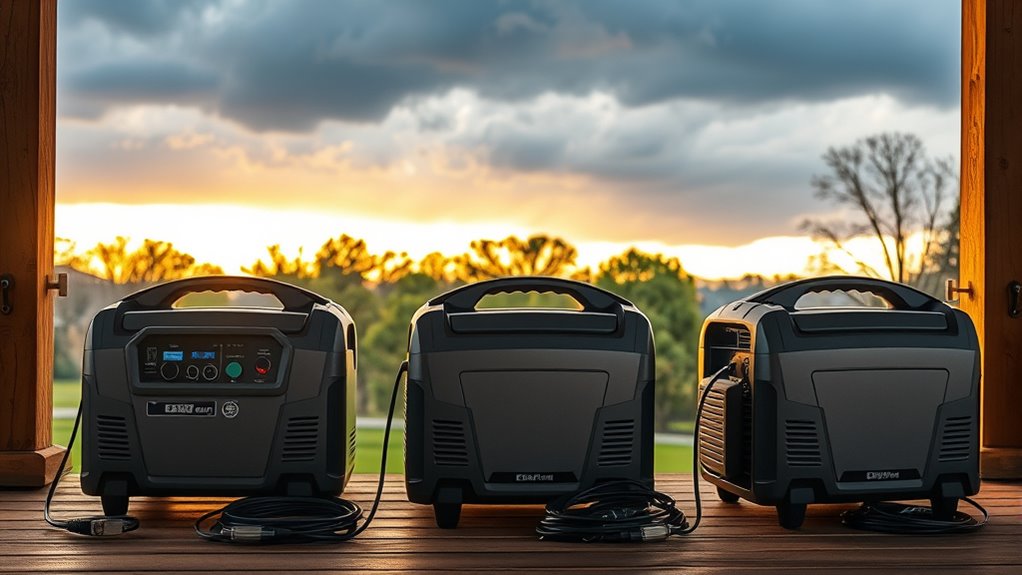If you’re looking for reliable backup power during outages, I recommend checking out the top models like the EcoFlow Delta 3, Jackery Explorer 2000 V2, and Anker SOLIX C1000. These offer high capacities, fast recharging, and multiple outlets to keep your essentials running. Lightweight options like the Jackery Explorer 300 are great for portability. To find the best fit for your needs, coming up, you’ll see detailed comparisons on capacity, features, and long-term durability.
Key Takeaways
- High-capacity batteries with fast recharge times ensure quick readiness during power outages.
- Durable, weather-resistant designs provide reliable outdoor and emergency backup performance.
- Multiple charging options, including solar, AC, and vehicle, guarantee versatile and continuous power supply.
- Wide power output ranges support essential household appliances, laptops, and small electronics safely.
- Long-lasting LiFePO4 batteries and extended warranties deliver dependable, durable performance over years of use.
EF ECOFLOW Portable Power Station DELTA 2

If you’re looking for a reliable backup power source that’s versatile and easy to transport, the EF ECOFLOW Portable Power Station DELTA 2 is an excellent choice. It features a robust 1024Wh LiFePO4 battery, providing up to 1800W AC power and 100W USB-C charging. The station charges quickly—80% in just 50 minutes—and can be expanded up to 3kWh with extra batteries. With 15 outlets, it can power most household appliances, making it perfect for home backup, camping, or RV adventures. Plus, its eco-friendly solar input and durable design guarantee long-lasting, sustainable power wherever you need it most.
Best For: individuals seeking a portable, reliable, and eco-friendly power solution for home backup, camping, or RV living.
Pros:
- Rapid charging from 0-80% in 50 minutes, ideal for quick power replenishment
- Expandable capacity up to 3kWh with additional batteries for extended off-grid use
- Multiple outlets (15 total) to run various appliances simultaneously without noise or fumes
Cons:
- Higher initial cost compared to smaller or less capable portable power stations
- Heavier weight due to large capacity, which may impact portability for some users
- Limited solar input capacity at 500W, which may require additional panels for faster solar charging
EF ECOFLOW DELTA 3 Portable Power Station
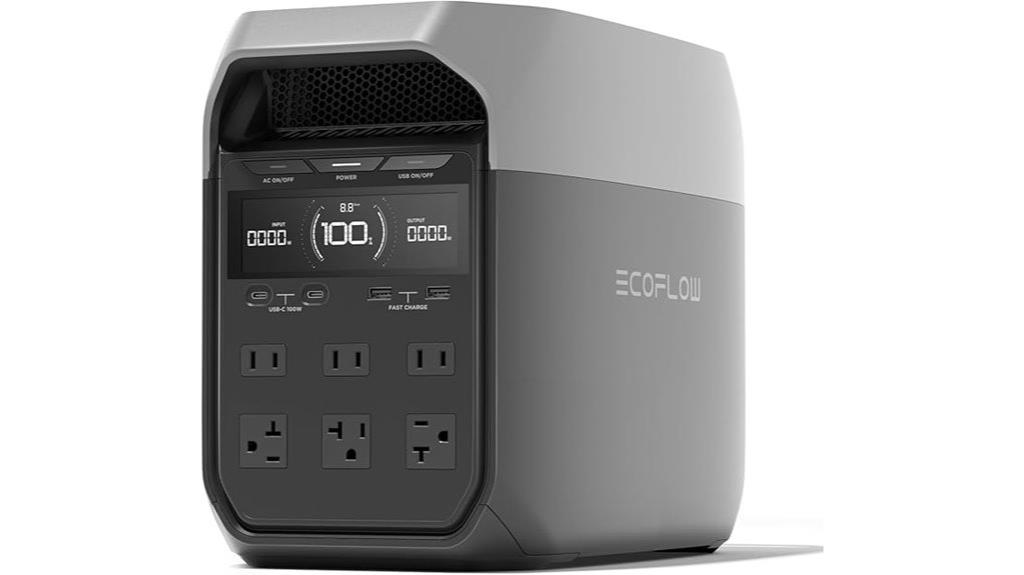
The EF ECOFLOW DELTA 3 Portable Power Station stands out as an excellent choice for those who need reliable, portable power, especially during outages or outdoor adventures. It features a robust 1024Wh LiFePO4 battery that charges fully in just 56 minutes and provides 1800W AC power, with a surge capacity of 2200W thanks to X-Boost. Supporting up to 13 devices simultaneously, it’s ideal for home backup, camping, or RV use. Expandable up to 5kWh with lighter, smaller extra batteries, it offers multiple fast charging options—solar, AC, vehicle, or smart generator—and is built to last with IP65 protection and a 5-year warranty.
Best For: individuals seeking a reliable, portable power solution for home backup, camping, or outdoor activities with fast recharging and expandability options.
Pros:
- Rapid full charge in just 56 minutes via solar or AC, saving time and ensuring quick readiness
- High capacity (1024Wh) and expandable up to 5kWh, suitable for extended outages or high power demand
- Supports simultaneous powering of up to 13 devices with multiple outlets and a user-friendly app for monitoring and control
Cons:
- Heavier at 27.5 pounds, which may affect portability for some users
- Higher price point compared to smaller or less feature-rich portable power stations
- Requires compatible extra batteries for expansion, which adds to overall cost and setup complexity
Jackery Portable Power Station Explorer 300
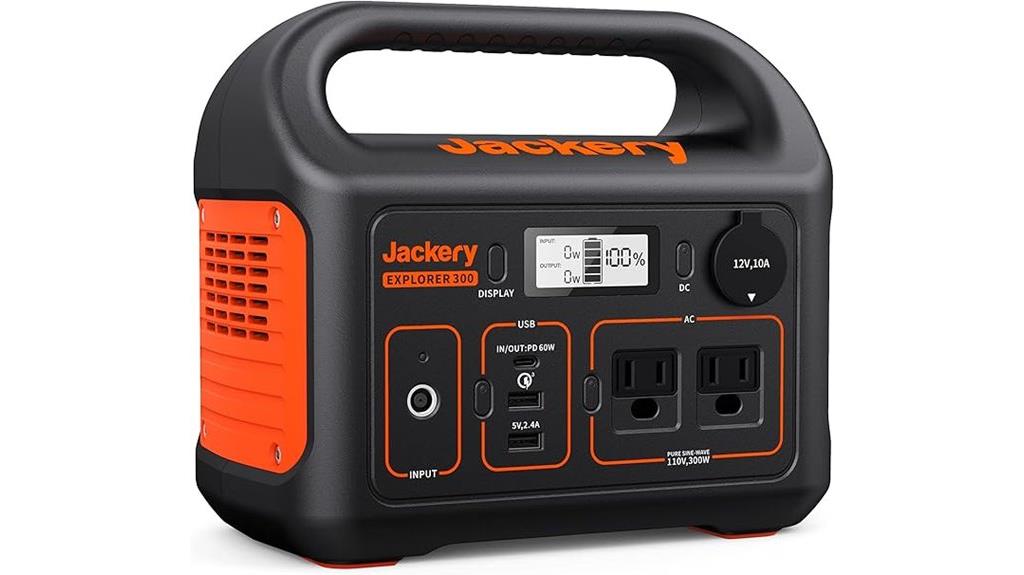
Looking for a lightweight backup power solution that can keep your essential devices running during outages or outdoor adventures? The Jackery Explorer 300 is a compact, 7.1-pound portable power station with a 293Wh lithium-ion battery. It features a 300W pure sine wave inverter, providing stable, safe power for devices like laptops, cameras, and lights. With multiple ports—including AC outlets, USB-C, USB-A, and a car port—it can power up to six devices simultaneously. Recharging is quick via wall outlet, car, or solar panels like the Jackery SolarSaga 100. Its reliability, ease of use, and versatility make it an excellent choice for emergencies and off-grid activities.
Best For: outdoor enthusiasts, campers, and emergency prepper seeking a lightweight, reliable backup power source for essential devices during outages or off-grid adventures.
Pros:
- Compact and lightweight at only 7.1 pounds, easy to transport and carry
- Multiple output options including AC, USB-C, USB-A, and car port for versatile device charging
- Fast recharging with wall outlet, car, or solar panels, and flow-through charging capability
Cons:
- Limited to 300W inverter capacity, not suitable for high-wattage appliances like induction cooktops
- Slightly limited battery capacity of 293Wh, which may require frequent recharges for extended use
- Not designed for very heavy-duty or industrial power needs
Anker SOLIX C1000 Gen 2 Portable Power Station

For those seeking a reliable backup power source that can handle multiple devices during outages or outdoor adventures, the Anker SOLIX C1000 Gen 2 Portable Power Station stands out with its impressive 2,000W continuous output and rapid recharge capability. It features a 1,024Wh LiFePO4 battery designed for durability, supporting over 4,000 cycles and a 10-year lifespan. Recharging in just 49 minutes via HyperFlash technology at 1,600W, or using solar panels in 1.8 hours, it’s versatile for off-grid use. Its compact, lightweight design includes multiple ports, UPS backup, and app control, making it a dependable, convenient power solution.
Best For: those in need of a reliable, portable power station for home backup, outdoor adventures, or off-grid living with fast recharging and versatile device support.
Pros:
- Rapid recharge time of just 49 minutes using HyperFlash technology at 1,600W
- High capacity with 2,000W continuous power and over 4,000 charge cycles for long-term durability
- Multiple output ports and app control for convenient, versatile device management
Cons:
- Heavier than some competing models, which may affect portability
- No built-in light or solar adapters included, limiting some outdoor or solar setup options
- Lacks DC pass-through mode, which can lead to additional battery cycles during simultaneous solar and battery use
MARBERO Portable Power Station 88Wh Camping Lithium Battery Solar Generator
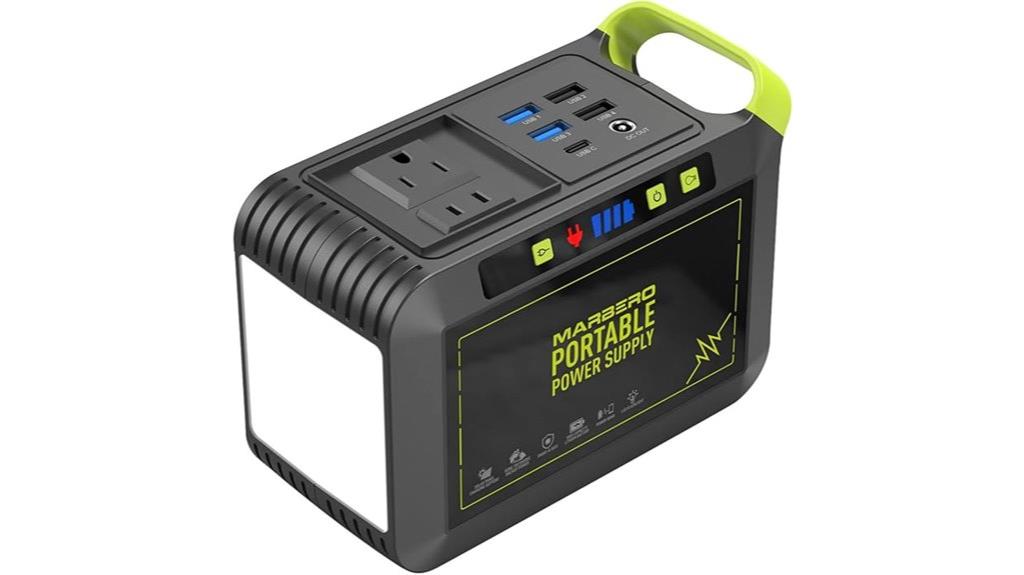
If you need reliable backup power for outdoor adventures or emergency situations, the MARBERO Portable Power Station 88Wh is an excellent choice due to its compact size and versatile charging options. Weighing just 3.2 pounds and about the size of a DSLR camera, it’s easy to carry and built from durable ABS material. It features eight output ports, including two AC outlets, USB-C PD, and a car DC port, making it suitable for charging phones, tablets, small appliances, and even a mini fridge. The built-in LED flashlight with SOS mode adds extra utility, and fast charging guarantees it reaches 80% in just two hours.
Best For: outdoor enthusiasts, campers, and emergency preparedness individuals seeking a portable, reliable power source for small devices and gadgets.
Pros:
- Compact and lightweight design, easy to carry and store
- Multiple charging ports including AC, USB-C PD, and car DC for versatile device compatibility
- Fast charging capability, reaching 80% in just two hours
Cons:
- Limited capacity may not support larger appliances like laptops or mini fridges for extended periods
- Battery life can degrade over time, leading to reduced performance and potential device power issues
- Basic LCD display provides limited information on remaining capacity and usage status
Anker SOLIX F2000 Portable Power Station

The Anker SOLIX F2000 Portable Power Station stands out as an ideal backup battery generator for those who need reliable, high-capacity power during outages or outdoor adventures. With a 2048Wh capacity and GaNPrime technology, it delivers efficient, long-lasting energy. Its LiFePO4 battery guarantees a 10-year lifespan, making it durable for daily use. Thanks to HyperFlash technology, it recharges from 0 to 80% in just 1.4 hours. It can power up to 12 devices simultaneously, supporting high-wattage appliances up to 3600W. Compact and portable, it’s perfect for home backup, camping, RVs, and solar setups, backed by a 5-year warranty.
Best For: individuals seeking a reliable, high-capacity portable power solution for home backup, outdoor adventures, RV travel, or solar energy setups.
Pros:
- High-capacity 2048Wh LiFePO4 battery with a 10-year lifespan for long-term durability
- Fast recharging from 0 to 80% in just 1.4 hours thanks to HyperFlash technology
- Supports up to 12 devices simultaneously with multiple outlets, including high-wattage appliances up to 3600W
Cons:
- Bulkier than smaller portable power options, which may impact portability for some users
- Higher initial cost compared to lower-capacity or less advanced models
- Requires optional solar panels for renewable energy, which are sold separately
BLUETTI EB3A Portable Power Station
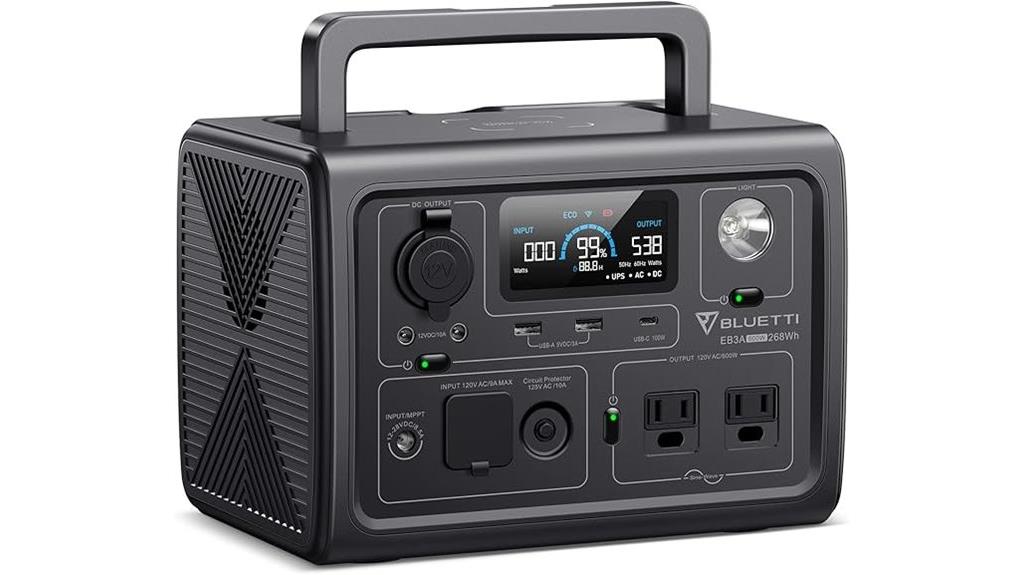
When I need reliable backup power for outdoor adventures or sudden outages, the BLUETTI EB3A Portable Power Station stands out thanks to its compact design and powerful 268Wh LiFePO4 battery. It features a 600W AC inverter with a 1200W surge capacity and nine outlets, making it versatile for charging devices, small appliances, or electronics. Its ultra-fast charging supports up to 350W, reaching 80% in just 30 minutes with a combined PV and AC setup. Plus, the built-in MPPT controller supports up to 200W solar input, allowing me to harness solar power. It’s a dependable, efficient option for both outdoor trips and emergency backup.
Best For: outdoor enthusiasts, emergency preparedness households, and travelers seeking reliable portable power solutions.
Pros:
- Compact and lightweight design for easy portability and storage
- Rapid charging capability, reaching 80% in just 30 minutes with combined PV and AC input
- Versatile with nine outlets and compatibility with solar panels for sustainable energy use
Cons:
- Solar charging cable not included, requiring an additional purchase for solar setup
- Limited solar input capacity of 200W, which may be insufficient for larger energy needs
- Battery capacity of 268Wh may be limited for extended power requirements during outages or long trips
BLUETTI Elite 100 V2 Portable Power Station
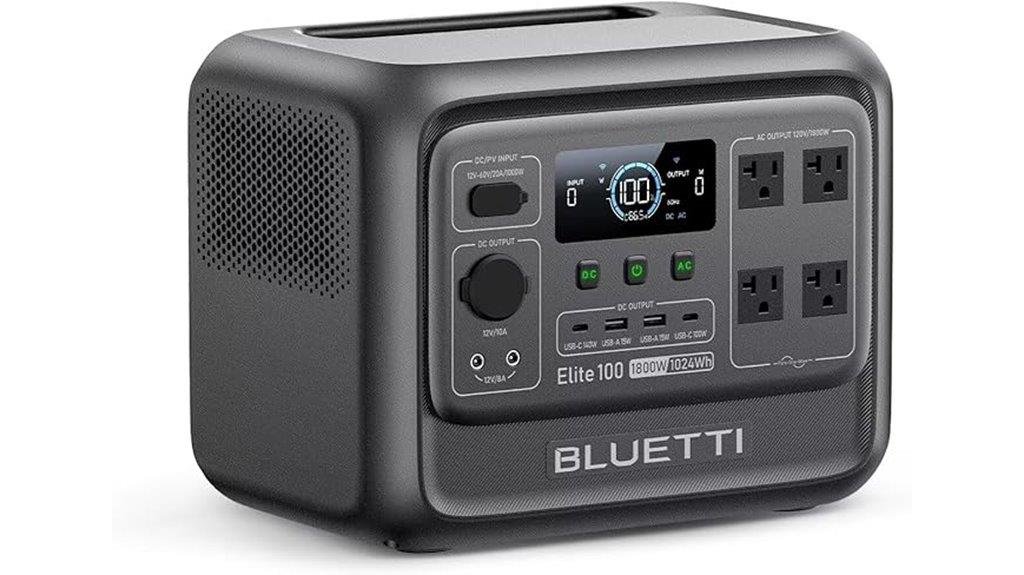
For anyone seeking a highly portable backup power source that can keep essential devices running during outages or outdoor adventures, the BLUETTI Elite 100 V2 Portable Power Station stands out. It offers a robust 1024Wh capacity with 1800W continuous power and 11 versatile outlets, including AC, USB, and DC ports. Weighing only 25 pounds and measuring 17 liters, it’s compact and easy to carry. Its lithium iron phosphate batteries provide safety, durability, and a long lifespan. Charging is quick—about 70 minutes with solar or AC—and it operates silently at just 30dB. Perfect for powering small appliances, electronics, and emergency devices on the go.
Best For: outdoor enthusiasts, emergency preparedness, and small-scale power needs who require a portable, reliable, and quick-charging power source.
Pros:
- Lightweight and compact design weighing only 25 lbs for easy portability
- Fast charging capabilities, fully charging in about 70 minutes via solar or AC power
- Quiet operation at just 30dB, ideal for use in quiet environments like camping or libraries
Cons:
- Lacks built-in lights and wireless charging features
- Limited to 1024Wh capacity, which may not suffice for larger appliances or extended outages
- Some users experience WiFi connectivity restrictions due to firmware limitations
Jackery Portable Power Station Explorer 500
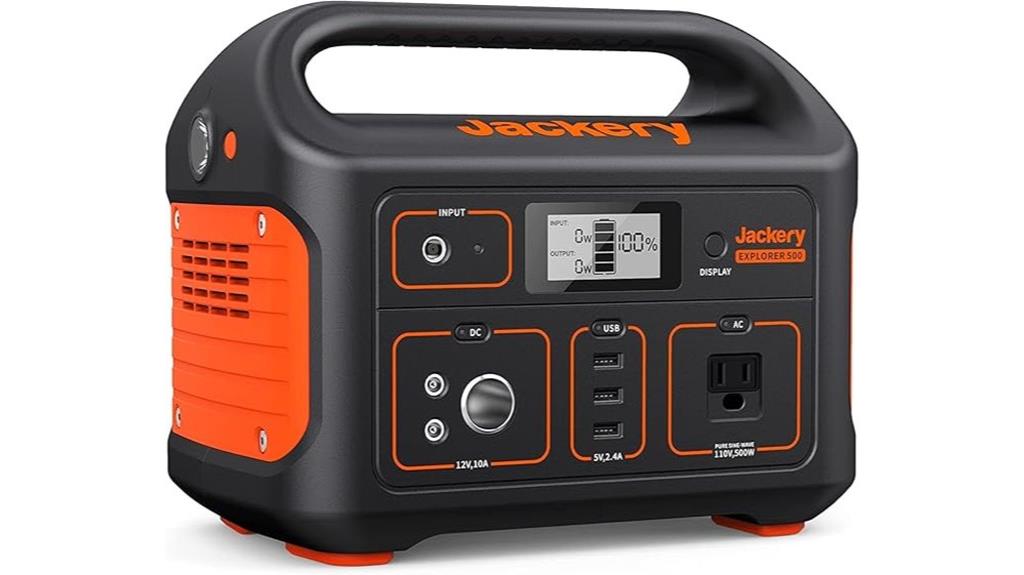
If you’re looking for a reliable backup power source that’s portable and easy to use, the Jackery Explorer 500 stands out as an ideal choice. With a 518Wh capacity, it’s compact—about the size of a basketball—and weighs just 13.3 pounds, making it perfect for camping, emergencies, or home backup. It features multiple outlets, including a 110V AC, USB-A, DC, and car ports, and supports charging via wall, car, or solar panels. Its rugged design, low noise, and straightforward operation make it user-friendly. Plus, its durable lithium-ion batteries and intelligent management system guarantee dependable performance during extended use or power outages.
Best For: outdoor enthusiasts, emergency preparedness, and homeowners seeking a portable, reliable backup power source.
Pros:
- Compact and lightweight design for easy portability
- Supports multiple charging options including solar, wall, and car power
- Durable lithium-ion batteries with intelligent management ensure long-lasting performance
Cons:
- May struggle to start charging with smaller solar panels like 60W
- Limited continuous power output of 500W, not suitable for high-wattage appliances
- Slightly higher price point compared to basic portable chargers
Portable Power Station 500W (Peak 1000W), 519Wh Solar Generator Backup Battery Pack
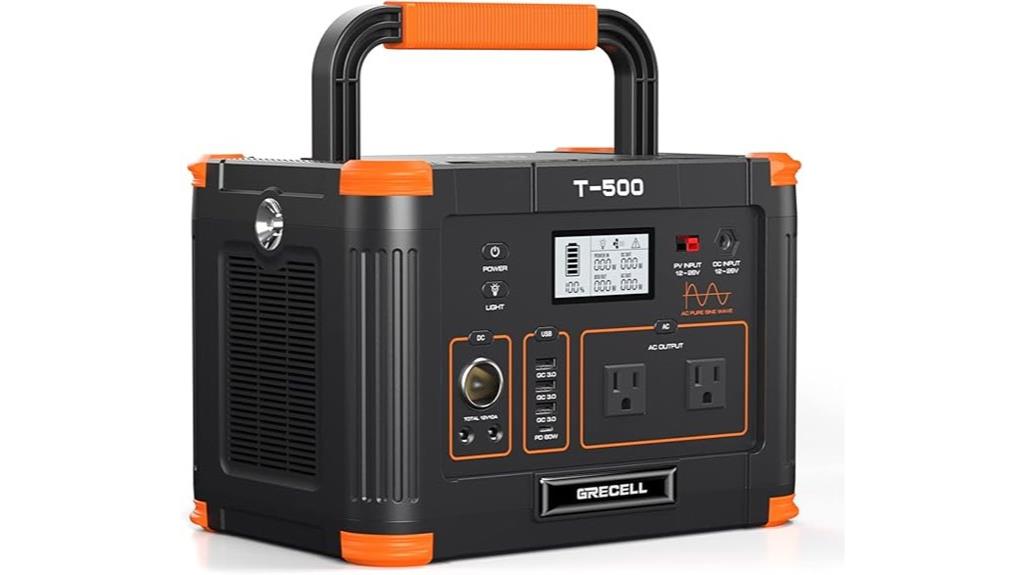
The Portable Power Station 500W (Peak 1000W), with its compact design and versatile output options, is ideal for outdoor enthusiasts and emergency preparedness. Weighing just 14.1 pounds, it offers 519Wh of reliable power through multiple outlets, including AC, USB-C, USB-A, DC, and a car port. It supports recharging via solar panels, wall outlets, or car chargers, making it flexible for various situations. The built-in Battery Management System guarantees safety and longevity, while the pure sine wave inverter protects sensitive electronics. Perfect for camping, home backup, or outdoor adventures, this unit delivers dependable power when you need it most.
Best For: outdoor enthusiasts, campers, and emergency preparedness individuals seeking a portable, reliable power source for small to medium devices.
Pros:
- Lightweight and compact design weighing only 14.1 lbs for easy portability
- Multiple charging options including solar, wall, and car, offering flexibility in various situations
- Built-in Battery Management System and pure sine wave inverter ensure safety and protection of sensitive electronics
Cons:
- Limited to powering devices under 500W, unsuitable for high-wattage appliances like kettles or heaters
- Input charging capacity is limited to 150W, which may slow down recharging times with some chargers
- Some users find the placement of input/output ports inconvenient, requiring modifications for certain setups
Jackery HomePower 3000 Portable Power Station
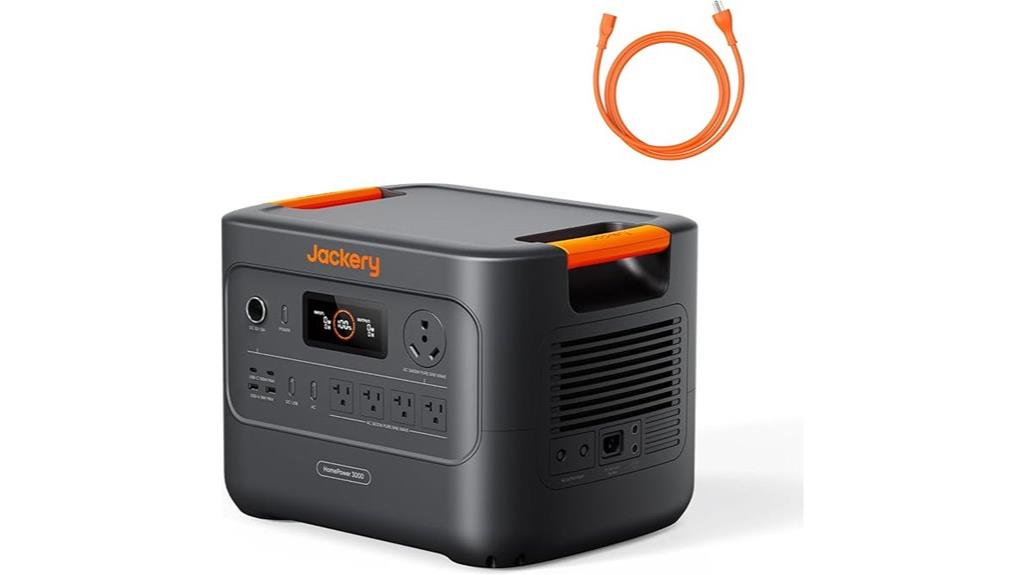
When reliable backup power is essential for home essentials or outdoor adventures, the Jackery HomePower 3000 Portable Power Station stands out with its impressive 3600W continuous output and 3072Wh capacity. It reliably powers essential devices like refrigerators, fans, WiFi, and lights for up to 15 hours, with seamless UPS switching during outages. Recharging takes just 1.7 hours with hybrid AC/DC or 2.2 hours via AC, and solar support allows up to 80% recharge in 9 hours. Its LiFePO4 batteries offer 4,000 cycles, ensuring long-term durability. Compact, lightweight, and safe with advanced technology, it’s an excellent choice for home backup and outdoor use.
Best For: homeowners, outdoor enthusiasts, and RV travelers seeking reliable, portable backup power with fast recharging and long battery life.
Pros:
- High continuous output of 3600W and 3072Wh capacity, suitable for powering multiple essential devices.
- Rapid recharging in just 1.7 hours via hybrid AC/DC and support for solar charging up to 80% in 9 hours.
- Long-lasting LiFePO4 batteries with 4,000 cycles ensure durability and sustained performance over time.
Cons:
- The size and weight may still be substantial despite being 43% lighter and 47% smaller than comparable models.
- Initial cost might be higher due to advanced technology and features.
- Limited to 80% recharge in 9 hours with solar panels, which may be slow in low sunlight conditions.
Jackery Explorer 1000 v2 Portable Power Station
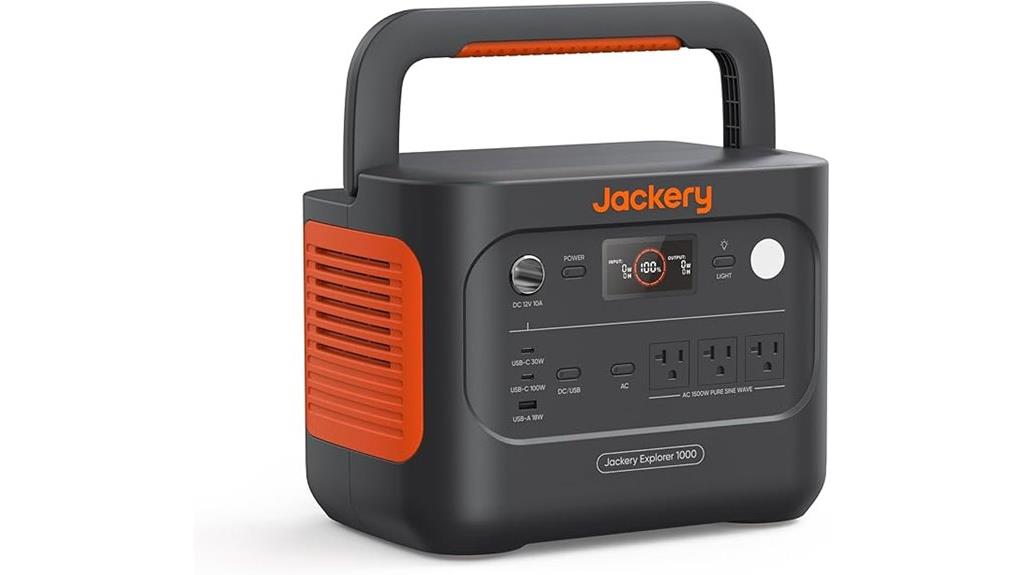
The Jackery Explorer 1000 v2 Portable Power Station stands out as an ideal option for outdoor enthusiasts, emergency preppers, or anyone needing reliable off-grid power, thanks to its massive 1070Wh LiFePO4 battery that retains over 70% capacity after 4,000 cycles. Weighing just 23.8 lbs with a foldable handle, it’s portable and easy to transport. It offers a true 1500W AC output, supporting multiple devices simultaneously through various ports, including USB-C, USB-A, and a DC car port. Fast charging and advanced safety features like ChargeShield 2.0 guarantee quick, safe recharging, making it a durable, long-lasting backup power solution.
Best For: outdoor enthusiasts, emergency preppers, and off-grid users seeking a portable, reliable power source with long battery life.
Pros:
- Large 1070Wh LiFePO4 battery with over 70% capacity retention after 4,000 cycles, ensuring longevity
- Lightweight and portable at only 23.8 lbs with a foldable handle for easy transport
- Supports multiple devices simultaneously with various ports and quick charging via the Jackery app
Cons:
- Limited to Jackery solar panels for solar charging, reducing compatibility options
- App management requires prior registration and updates may necessitate re-login
- Higher price point compared to some alternative portable power stations
Anker SOLIX C1000 Portable Power Station (Optional Solar Panel)
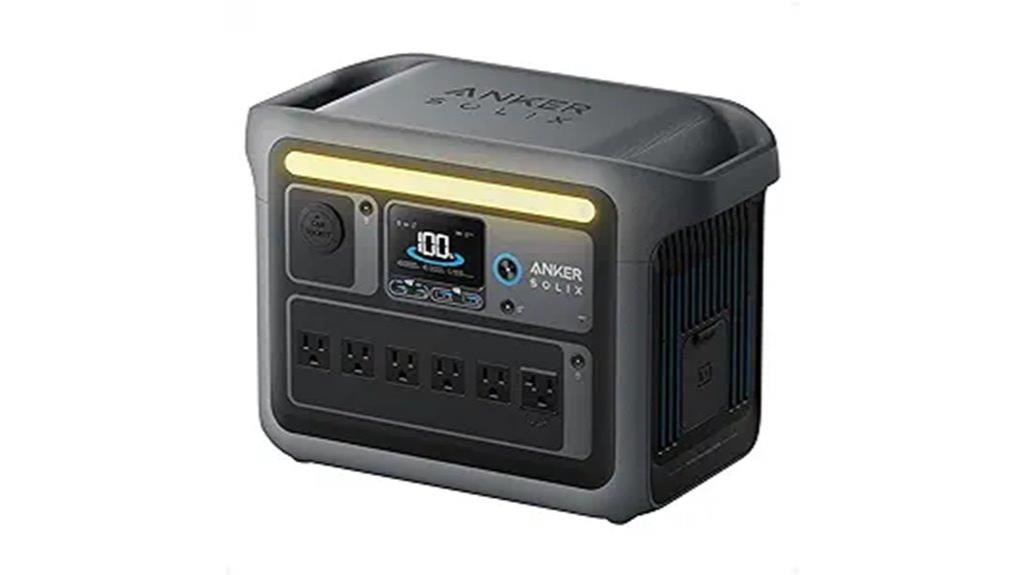
If you’re looking for a reliable portable power source that can handle heavy-duty appliances and outdoor adventures, the Anker SOLIX C1000 Portable Power Station is an excellent choice. It delivers 1800W continuous power and peaks at 2400W, thanks to its robust 1056Wh LiFePO4 battery designed for over 3,000 cycles. Weighing only 27.6 pounds and 15% smaller than similar units, it’s perfect for camping, RV trips, or emergency backup. It features 11 versatile outlets, fast recharging (80% in 43 minutes), and eco-friendly solar charging up to 600W, powering the unit fully in under two hours. Its user-friendly interface and durable build make it highly dependable on the go.
Best For: outdoor enthusiasts, RV travelers, and households needing reliable backup power for heavy-duty appliances and off-grid use.
Pros:
- Powerful 1800W continuous output with peak of 2400W, capable of running high-wattage devices.
- Fast recharging times, reaching 80% in 43 minutes and fully charging in under an hour with AC or solar.
- Compact, lightweight design (27.6 pounds) with durable build and versatile outlets for multiple device types.
Cons:
- Limited solar input capacity of 600W may require additional panels for faster recharging in some scenarios.
- WiFi connectivity and app notifications could be improved for more stable remote management.
- Higher initial cost compared to smaller portable power banks, though justified by capacity and features.
BLUETTI Portable Power Station AC180, 1152Wh Lithium Battery

For anyone seeking a reliable backup power source that’s portable and quick to recharge, the BLUETTI AC180 stands out. It features a robust 1152Wh LiFePO4 battery that can be fully recharged in just an hour via 1440W AC input, making it incredibly efficient. With an 1800W continuous output (peaking at 2700W), it powers a variety of appliances, from laptops to small home devices. Weighing 37.4 pounds and compact enough for camping or emergency use, it supports solar charging and pass-through power, ensuring versatile, reliable energy during outages or outdoor adventures. Its fast recharge and high capacity make it a top choice.
Best For: outdoor enthusiasts, emergency preparedness, and off-grid users seeking a portable, fast-charging power station for various appliances and devices.
Pros:
- Rapid recharging time of just 1 hour via AC input, ensuring minimal downtime
- High capacity of 1152Wh with LiFePO4 chemistry for safety and longevity
- Multiple outlets (8 AC ports) and support for external batteries, enabling versatile use and extended runtime
Cons:
- Weighs 37.4 pounds, which may be less convenient for frequent transport
- Standby power drain of approximately 15W, potentially reducing battery life if left unused long-term
- Slight power loss during input/output efficiency, around 69-77%, which could impact overall energy use
Jackery Explorer 2000 v2 Portable Power Station
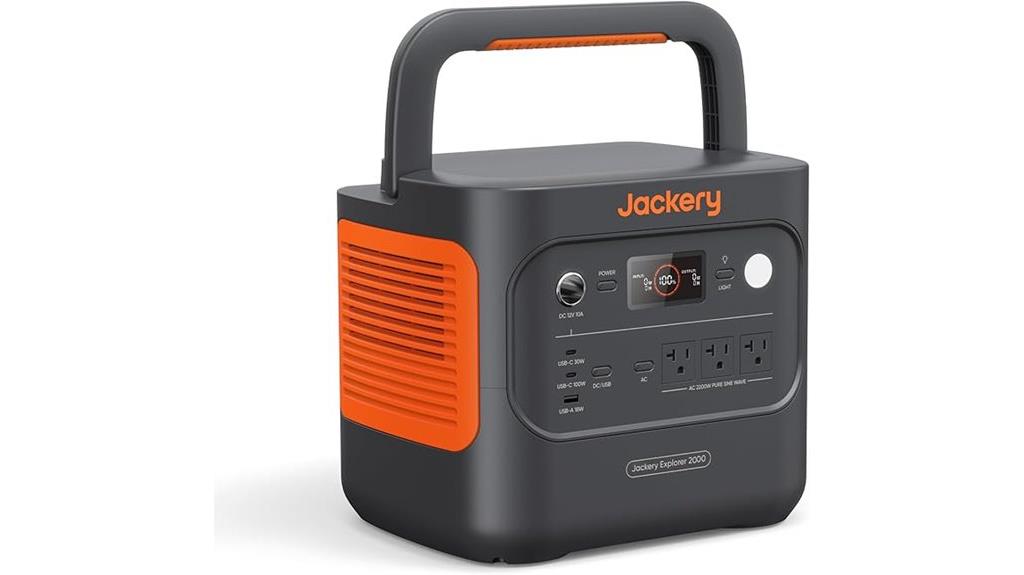
When selecting a backup battery generator capable of handling multiple devices during an outage or outdoor adventure, the Jackery Explorer 2000 v2 stands out with its impressive 2042Wh LiFePO4 battery and 2200W continuous power output. It features three AC outlets, a fast-charging USB-C port, and seamless pass-through charging, making it versatile and reliable. Weighing only 39.5 pounds, it’s more portable than many similar units, thanks to advanced Cell-to-Body technology for durability. It can power essentials like refrigerators, laptops, and small appliances for hours, serving effectively as a UPS during outages, and is suitable for camping, emergency backup, or daily use.
Best For: outdoor enthusiasts, homeowners seeking reliable backup power, and small business owners needing portable energy solutions.
Pros:
- High-capacity 2042Wh LiFePO4 battery ensures long-lasting power for multiple devices.
- Lightweight design at 39.5 lbs makes it highly portable and easy to transport.
- Supports fast charging and seamless pass-through, enabling quick recharges and continuous power during outages.
Cons:
- Initial setup and Wi-Fi connectivity may pose challenges for some users.
- The unit’s price can be high outside of promotional discounts, potentially limiting accessibility.
- While designed for durability, long-term performance and battery lifespan are best confirmed through extended use.
Factors to Consider When Choosing Backup Battery Generators
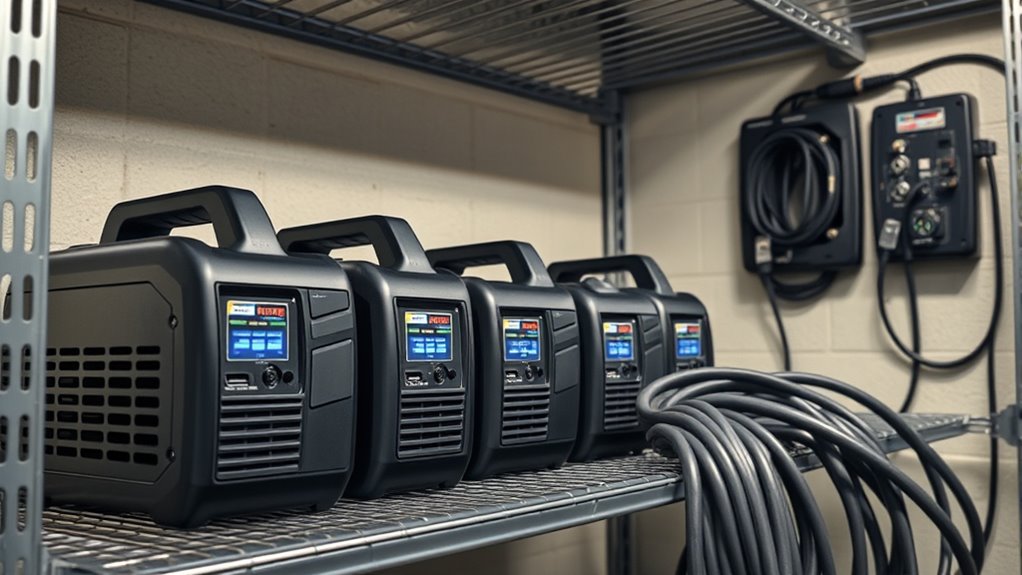
When choosing a backup battery generator, I consider factors like how much power I need and whether the device is portable enough for my use. I also look at recharging options, runtime, durability, and how safe and reliable the generator is. Keeping these points in mind helps me select the best option for my specific needs.
Power Capacity Needs
Choosing the right backup battery generator starts with accurately evaluating your power capacity needs. I recommend calculating the total wattage of all devices you plan to run simultaneously. This helps guarantee you select a generator with enough capacity to handle your essential appliances without overload. It’s also important to take into account surge wattage, especially for devices with motors or compressors, which need extra power during startup. Your battery’s capacity in watt-hours (Wh) or amp-hours (Ah) should comfortably exceed your total energy consumption for the intended runtime. Additionally, think about future needs—opt for models with expandable capacity or multiple outlets. This way, your generator can adapt as your power needs evolve, providing reliable backup when you need it most.
Portability and Size
Selecting a backup battery generator that fits your portability needs begins with examining its size and weight. Smaller, lighter models are easier to carry during outdoor activities or emergencies, making them ideal for on-the-go use. Look for built-in handles, wheels, or compact designs that make transportation simpler without sacrificing capacity or features. It’s also important to contemplate the overall size to ensure it fits comfortably in storage spaces, vehicles, or designated backup areas. Keep in mind that increased portability often means a trade-off with battery capacity or power output, so find a balance that meets your specific needs. Portable generators can range from under 10 pounds to over 40 pounds — choose one based on how easily and frequently you plan to move it around.
Recharging Options
Recharging options are a vital factor to take into account because they determine how quickly and conveniently your backup generator can regain full power. Some models support fast recharging, achieving 0-80% in under an hour, which is essential during emergencies or short outages. Solar panels offer eco-friendly recharging, especially with high-wattage inputs and MPPT technology that maximize sunlight efficiency. Vehicle alternators and external power sources add versatility, ensuring you’re not limited to a single method. Pass-through charging allows simultaneous recharging and device operation, maintaining power continuity. The compatibility with multiple sources and recharge speed greatly influence usability, especially in off-grid or emergency scenarios. Overall, flexible and rapid recharging options make a backup generator more reliable and convenient when you need it most.
Runtime and Durability
When evaluating backup battery generators, understanding their runtime and durability helps guarantee they’ll meet your needs during outages. Runtime depends on the generator’s capacity—measured in Wh or Ah—and the power draw of connected devices. Larger capacities provide longer backup periods. Durability hinges on the battery’s cycle life; batteries like Lithium Iron Phosphate (LiFePO4) often deliver over 3000 cycles, far surpassing traditional lithium-ion options. A robust internal management system (BMS) safeguards against overvoltage, overcurrent, and thermal stress, extending the battery’s lifespan. Regular maintenance and avoiding complete discharges also help improve runtime and durability. By considering these factors, you can select a generator that not only lasts longer but reliably powers your essential devices when you need it most.
Safety and Reliability
Ensuring safety and reliability is essential when choosing a backup battery generator, especially since it will be powering essential devices during outages. I recommend selecting models equipped with Battery Management Systems (BMS) that automatically regulate safety features like overvoltage, overcurrent, and short circuits. opt for lithium iron phosphate (LiFePO4) batteries, which provide over 3,000 charge cycles and last 8-10 years, offering long-term safety and dependability. Check that the generator meets UL safety standards or equivalent certifications, ensuring it has undergone rigorous testing. Additionally, look for surge capacity ratings that surpass typical appliance startup loads to prevent overloads. Regularly updating firmware and safety features is also critical for maintaining peak protection and reliable operation over time.
Frequently Asked Questions
How Long Do Backup Batteries Typically Last During Extended Outages?
Backup batteries usually last anywhere from a few hours to over a day during extended outages, depending on their capacity and the devices plugged in. I’ve found that larger, high-capacity units can often power essential appliances for 12-24 hours. It’s important to contemplate your power needs and choose a battery with enough capacity to keep critical devices running longer. Proper maintenance and efficient usage also help extend their runtime.
Can Backup Generators Safely Power Sensitive Electronics and Appliances?
Ever wondered if your sensitive gadgets are safe during a power outage? Yes, backup generators can safely power delicate electronics if they have clean, stable power output. I always recommend using models with inverter technology, which provides consistent, high-quality electricity similar to the grid. This way, your laptops, medical devices, or cameras stay protected from surges or dips, ensuring they operate smoothly without risk.
Are There Any Maintenance Requirements for Portable Power Stations?
Yes, portable power stations do require some maintenance to keep them running smoothly. I recommend charging them regularly, even when not in use, to prevent battery degradation. Keep the vents clean and dry, and store them in a cool, dry place. Periodically check for firmware updates if applicable, and make sure all connections are secure. Proper maintenance ensures your power station stays reliable whenever you need it most.
How Do Weather Conditions Affect Solar Charging Efficiency?
Weather conditions can substantially impact solar charging efficiency. I’ve found that direct sunlight boosts charging speeds, while cloudy or rainy days reduce it because less sunlight reaches the panels. Extreme temperatures, like intense heat or cold, can also affect battery performance and longevity. To get the best results, I try to position my solar panels in ideal sunlight and avoid harsh weather whenever possible.
What Safety Precautions Should Be Taken When Using Backup Power Sources?
When using backup power sources, I always prioritize safety. I avoid overloading outlets and make sure the devices are properly grounded. I keep the area dry and away from water to prevent electrical hazards. I also read the manufacturer’s instructions carefully and wear protective gear if needed. Regular maintenance and inspections help me catch potential issues early, ensuring I stay safe while keeping my power reliable during outages.
Conclusion
Choosing the right backup battery generator is like finding a reliable friend—powerful yet portable. While some offer lightweight convenience, others boast massive capacity for long outages. It’s a balance between size, power, and your specific needs. Remember, the perfect backup isn’t just about staying connected; it’s about peace of mind during life’s unexpected outages. So, weigh your options carefully—because when the lights go out, your choice makes all the difference.
